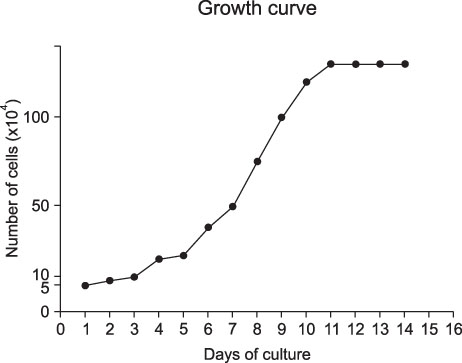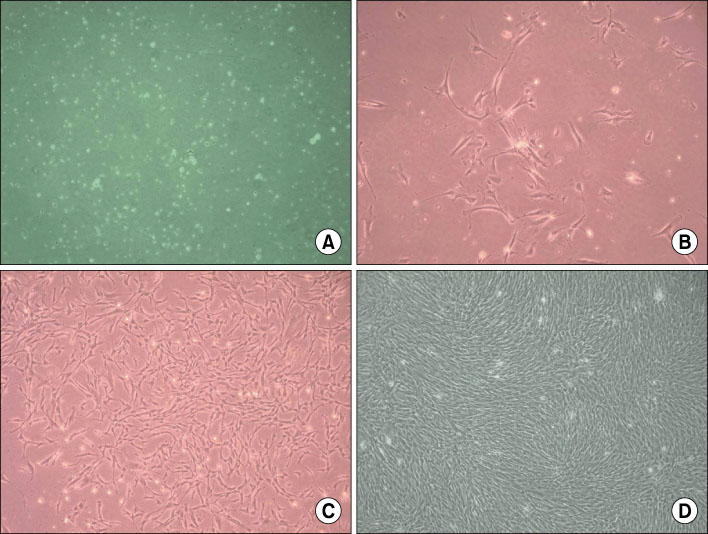Chonnam Med J.
2011 Aug;47(2):85-89. 10.4068/cmj.2011.47.2.85.
Establishment of a Cell Line (CNUH-HNSCC-1) Derived from an Advanced Laryngeal Squamous Cell Carcinoma
- Affiliations
-
- 1Department of Otorhinolaryngology-Head and Neck Surgery, Chonnam National University Medical School Hwasun Hospital, Hwasun, Korea.
- 2Research Institute of Medical Sciences, Chonnam National University, Gwangju, Korea. joonkyoo@chonnam.ac.kr
- KMID: 2048790
- DOI: http://doi.org/10.4068/cmj.2011.47.2.85
Abstract
- Cancer cell lines are the basic material for various lines of cancer research. Diverse cancer cell lines derived from tissues of various head and neck regions are needed for biological research on head and neck cancer. However, cell lines derived from cancer of the head and neck are not common. Recently, we established and characterized a novel human squamous carcinoma cell line, CNUH-HNSCC-1. From six cases of head and neck cancer, we established one specimen that was maintained for over 50 passages. We characterized the cell line as follows: growth patterns and curve, morphology by use of phase-contrast microscopy, and tumorigenicity by implanting the cell line into nude mice and making morphological comparisons. CNUH-HNSCC-1 cells grew well in vitro even after passage 50. However, the cells failed to form tumors in nude mice. CNUH-HNSCC-1 cells could be used as a control cell line for studying the biology of head and neck cancer.
MeSH Terms
Figure
Reference
-
1. Kim KH, Chung PS, Park HM, Rhee CS, Park JG. Establishment and characterization of cell lines derived from squamous cell carcinoma of the head and neck. Korean J Head Neck Oncol. 1996. 12:181–187.2. Jun HK, Kim SY, Gong GY. Histologic similarity between the primary tumor and xenograft of AMC-HN cell lines in nude mice. Korean J Otolaryngol-Head Neck Surg. 1997. 40:1546–1553.3. Kim SY, Chu KC, Lee HR, Lee KS, Carey TE. Establishment and characterization of nine new head and neck cancer cell lines. Acta Otolaryngol. 1997. 117:775–784.
Article4. Roh HJ, Goh EK, Wang SG, Chon KM, Kim YS, Han JY. Establishment and characterization of a novel cell line (PNUH-12) derived from a human squamous cell carcinoma of the hypopharynx. Korean J Otolaryngol-Head Neck Surg. 1999. 42:72–81.5. Krause CJ, Carey TE, Ott RW, Hurbis C, McClatchey KD, Regezi JA. Human squamous cell carcinoma. Establishment and characterization of new permanent cell lines. Arch Otolaryngol. 1981. 107:703–710.
Article6. Eagle H. Nutrition needs of mammalian cells in tissue culture. Science. 1955. 122:501–514.
Article7. Giard DJ, Aaronson SA, Todaro GJ, Arnstein P, Kersey JH, Dosik H, et al. In vitro cultivation of human tumors: establishment of cell lines derived from a series of solid tumors. J Natl Cancer Inst. 1973. 51:1417–1423.
Article8. Easty DM, Easty GC, Carter RL, Monaghan P, Butler LJ. Ten human carcinoma cell lines derived from squamous carcinomas of the head and neck. Br J Cancer. 1981. 43:772–785.
Article9. Rupniak HT, Rowlatt C, Lane EB, Steele JG, Trejdosiewicz LK, Laskiewicz B, et al. Characteristics of four new human cell lines derived from squamous cell carcinomas of the head and neck. J Natl Cancer Inst. 1985. 75:621–635.10. Carey TE. Hay R, Gazdar A, Park JG, editors. Head and neck tumor lines. Atlas of Human Tumor Cell Lines. 1994. Orlando, FL: Academic Press;79–120.11. Baker SR. An in vivo model for squamous cell carcinoma of the head and neck. Laryngoscope. 1985. 95:43–56.
Article12. Rheinwald JG, Beckett MA. Tumorigenic keratinocyte lines requiring anchorage and fibroblast support cultures from human squamous cell carcinomas. Cancer Res. 1981. 41:1657–1663.13. Heo DS, Snyderman C, Gollin SM, Pan S, Walker E, Deka R, et al. Biology, cytogenetics, and sensitivity to immunological effector cells of new head and neck squamous cell carcinoma lines. Cancer Res. 1989. 49:5167–5175.14. Ang KK, Berkey BA, Tu X, Zhang HZ, Katz R, Hammond EH, et al. Impact of epidermal growth factor receptor expression on survival and pattern of relapse in patients with advanced head and neck carcinoma. Cancer Res. 2002. 62:7350–7356.15. Grandis JR, Tweardy DJ. Elevated levels of transforming growth factor alpha and epidermal growth factor receptor messenger RNA are early markers of carcinogenesis in head and neck cancer. Cancer Res. 1993. 53:3579–3584.16. Lara PC, Cuyás JM. The role of squamous cell carcinoma antigen in the management of laryngeal and hypopharyngeal cancer. Cancer. 1995. 76:758–764.
Article17. Snyderman CH, D'Amico F, Wagner R, Eibling DE. A reappraisal of the squamous cell carcinoma antigen as a tumor marker in head and neck cancer. Arch Otolaryngol Head Neck Surg. 1995. 121:1294–1297.
Article18. Sandström K, Nestor M, Ekberg T, Engström M, Anniko M, Lundqvist H. Targeting CD44v6 expressed in head and neck squamous cell carcinoma: preclinical characterization of an 111In-labeled monoclonal antibody. Tumour Biol. 2008. 29:137–144.19. Reategui EP, de Mayolo AA, Das PM, Astor FC, Singal R, Hamilton KL, et al. Characterization of CD44v3-containing isoforms in head and neck cancer. Cancer Biol Ther. 2006. 5:1163–1168.20. Lee JK, Bae JA, Sun EG, Kim HD, Yoon TM, Kim K, et al. KITENIN increases invasion and migration of mouse squamous cancer cells and promotes pulmonary metastasis in a mouse squamous tumor model. FEBS Lett. 2009. 583:711–717.
Article21. Lee JK, Yoon TM, Seo DJ, Sun EG, Bae JA, Lim SC, et al. KAI1 COOH-terminal interacting tetraspanin (KITENIN) expression in early and advanced laryngeal cancer. Laryngoscope. 2010. 120:953–958.
Article22. Lee JK, Lim SC, Kim HD, Yoon TM, Kim K, Nam JH, et al. KITENIN represents a more aggressive phenotype in a murine model of oral cavity squamous carcinoma. Otolaryngol Head Neck Surg. 2010. 142:747–752.
Article
- Full Text Links
- Actions
-
Cited
- CITED
-
- Close
- Share
- Similar articles
-
- Effects of p27 Overexpression on Head and Neck Squamous Cell Carcinoma Cell Lines
- Analysis of Chromosomal Aberrations in Head and Neck Squamous Cell Carcinoma Cell Lines using CGH
- Immunotherapy in Head and Neck Squamous Cell Cancer
- Expression of Cyclooxygenase 1 and 2 in Laryngeal Squamous Cell Carcinoma
- Expression of Vascular Endothelial Growth Factor and Platelet-Derived Endothelial Cell Growth Factor in Head and Neck Squamous Cell Carcinoma and It's Relation to Angiogensis




